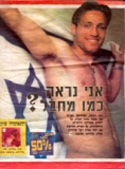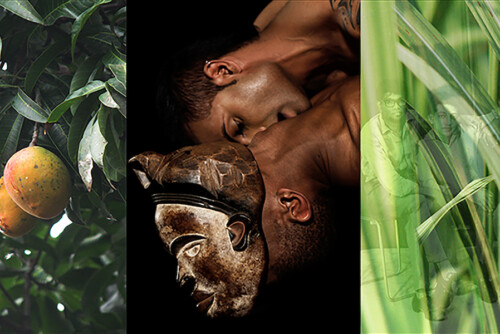
The picture on the right was taken from the cover page of the Hebrew Israeli magazine Anashim 1 from April 24, 2000. Although at a first glance it looks like just another tabloid eye catcher, its multilayered subtext touches fundamental issues concerning the interrelated construction of ethno-national and gender identities in Israel. The man leaning on the Israeli national flag is Sami Daniel, an Arab citizen of Israel, and the main title in Hebrew is a rhetorical question: “Do I look like a terrorist?”
Daniel certainly does not look like a terrorist. An Israeli flag is stuck to Daniel’s skin and he is smiling. Terrorists, as every child knows, are dark and hairy. Daniel is surrounded by bright colors and is far from hairy. Furthermore, the popular image of contemporary Palestinian terrorists includes conservative religiosity, and they are not expected to expose their naked bodies in public.
The marketing of an Arab man as a sex symbol in a Hebrew magazine is not self-evident and might be considered highly provocative in the context of the Israeli-Palestinian conflict. Hebrew Israeli popular culture includes frequent examples of a latent anxiety toward the sexuality of Arab men, which combines dark magic with moral claims of a nationalist challenge 2. The disarming of this sexuality was enabled here by the de-orientalization of an Arab man, and the dissolving of the link between sexuality and nationalist aggression. The photo suggests that Daniel is a bright-skinned, sexy Arab man, attractive to Jewish girls. He is an Israeli patriot and has no nationalist aspirations as an Arab.
Obviously, Daniel’s Nordic-like coloring makes him an excellent candidate to play this role. I would like to argue, however, that there is another important dimension to his identity that allows him to be the embodiment of an unthreatening masculinity: Daniel is a soccer player, who became a local celebrity by playing in the first Israeli Division in 2000. This picture not only captures the historical attempt of the Jewish Israeli majority to tame the Arab man, but it also represents the importance of sports, specifically soccer, in this “taming process.” The subtitle of the magazine explicitly connects Daniel’s identity as a soccer player with the conversion of nationalist aspirations into sexual desires: “Sami Daniel, The Arab player of ‘Maccabi Petah Tikva’ [a Jewish team], speaks on life in the state of the Jews (and Jewish girls).”
This article provides a broader context for understanding this popular visual text and its relevance to women’s exclusion from Israeli soccer. Feminist studies have emphasized that the emergence of modern sports in Europe and in the United States was tightly related to the crisis of masculinity and the need to create an exclusive sphere of masculine socialization. 3 Similarly, in Israel, sports in general and soccer in particular have been a sphere where Jewish men from Europe (Ashkenazi men), Arab Palestinian men, and Jewish men from Muslim countries (Mizrahi men), have all attempted to rehabilitate a threatened masculinity, to de-orientalize, and “modernize” their self-image. The triangular struggle between these three different groups of men, has set significant obstacles in the way of the inclusion of women in Israeli sports.
In this regard, soccer is particularly important, as soccer in Israel can be described as hegemonic sports culture. Markovits and Hellerman define “hegemonic sports cultures” as “the sport cultures that dominate a country’s emotional attachments.” 4 They are “what people breathe, read, discuss, analyze, and historicize.” Therefore, the term “hegemonic sport culture” refers to the sport that contains and produces the highest levels of political power. These are the sports that provoke the strongest collective emotions of pride, joy, and frustration in watching other people, whom one has never met personally, winning or losing. Unlike other sports, these sports usually attract fans from diverse social classes, and very frequently they are a focus of national pride, either through international competitions or through a common belief that they represent the nation’s character.
A major aspect of hegemonic sports is their exclusion of women as participants, and their construction of dominant images of heterosexual masculinity, which is very frequently identified with toughness, robustness, and roughness. Soccer in Israel is one of two hegemonic sports cultures, the second being basketball; it is the more popular of the two, particularly among the working class. This status of soccer makes it a multi-dimensional contested terrain where gender, class, ethnic, and national identities are in constant struggle and are constantly being negotiated.
European Jewish and Arab masculinities under threat
Cynthia Enloe argues that “nationalism has typically sprung from masculinised memory, masculinised humiliation, and masculinised hope.” 5 Respectively, both Zionism and the Palestinian national movement were partly an attempt to “redeem manhood through nationalism.” 6 The particular dynamics of the Arab-Jewish encounter in the realm of sports are highly influenced by the historical crisis of collective images of masculinity and the construction of national identities on both sides of the conflict.
As several scholars of Zionism and sexuality have shown, the way in which early Zionist leaders saw the body of the European Jewish man reflected a remarkable internalization of contemporary anti-Semitic stereotypes and pseudo-scientific literature, which found the Jewish male body inferior and drew similarities between the physiology of Jewish men and female bodies. 7 Therefore, Zionism strove to redeem the Jewish man from his “femininity” by “converting” him into “an Aryan man.” The “sportization” of the Jew was seen as a cure to his non-masculine character. In his extensively quoted speech from 1898, Dr. Max Nordau called for the establishment of a “Muscular Jewry” and emphasized the link between national redemption and masculine re-habilitation: “We shall develop a wide chest, strong limbs, a courageous look – we will become a people of valor. Sport is educationally significant to us, the Jews, for not only do we have to recover physically, but also spiritually.” 8
In the decades after Naurdau’s speech, Jewish sports clubs were established all over Europe, and several large scale Zionist sports organizations were founded. Although women were included in this movement, its predominantly masculine orientation was evident both in quantitative terms and in the rhetoric surrounding it. The names given to sports clubs, for example, reflected the yearning for mythological muscular warriors found in the Jewish ancient past: for example Maccabi, Shimshon (Samson), Bar-Kokhba, and so on. When the State of Israel was founded in 1948, these organizations were well established and active in Palestine, directing competitions on both local and international levels.
- An Israeli imitation of the American magazine People.[↑]
- Raz Yosef, “Homoland: Interracial Sex and the Israeli-Palestinian Conflict in Israeli Cinema.” A Journal of Lesbian and Gay Studies 8, no. 4 (2002): 553-579.[↑]
- Messner, Michael, Power at Play: Sports and the Problem of Masculinity. (Boston: Beacon Press, 1992), 9-13.[↑]
- Andrei Markovits and Steven Hellerman, Offside: Soccer and American Exceptionalism in Sport (Princeton, N.J.: Princeton University Press, 2001), 10.[↑]
- Cynthia Enloe, Bananas, Beaches, & Bases: Making Feminist Sense of International Politics (Berkeley: University of California, 1989), 44.[↑]
- Sheila Hannah Katz, “Adam and Adama, ‘Ird and Ard: Engendering Political Conflict and Identity in Early Jewish and Palestinian Nationalisms,” in Gendering the Middle East: Emerging Perspectives, ed. Deniz Kandiyoti (Syracuse: Syracuse University Press, 1996).[↑]
- David Biale, Eros and the Jews: From Biblical Israel to Contemporary America (New York: Basic Books, 1992); Daniel Boyarin, “Outing Freud’s Zionism, or, the Bitextuality of the Diaspora Jew,” in Queer Diasporas, ed. Cindy Patton and Benigno Sánchez-Eppler (Durham, NC: Duke University Press, 2000).[↑]
- Steve Israel and Seth Forman, Great Jewish Speeches throughout History (Northvale NJ: Jason Aronson, 1994).[↑]



